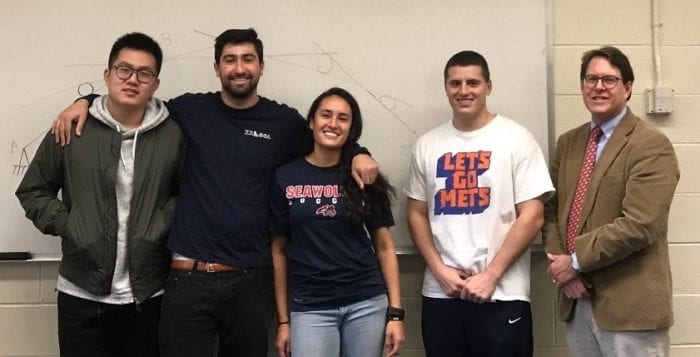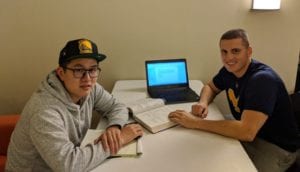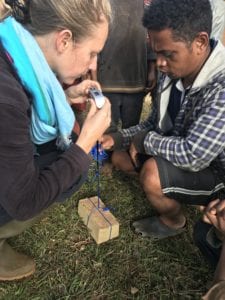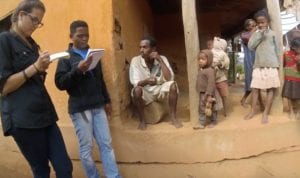SBU students and BeLocal build bridges with Madagascar

By Daniel Dunaief

Johnny Donza wants to use the training he’s received as an engineering undergraduate at Stony Brook University to help people 8,600 miles and another continent away in Madagascar.
The group leader of a senior project, Donza is working with Yuxin Xia, Luke Papazian and Manuela Corcho to design and hopefully help build a bridge that will cross a stream on the outskirts of the village of Mandrivany. People living in that village had been walking across a log that has broken to buy and sell food or get to a hospital.
“I wanted to be involved in something that would make an impact,” said Donza, who is studying civil engineering with a concentration in structural engineering. This project presented an opportunity to help “people on the opposite side of the world. I thought that was pretty cool.”
Donza’s project is one of 15 senior design efforts that arose from a collaboration between Stony Brook and a group called BeLocal. The company sent Stony Brook graduates Acacia Leakey and Leila Esmailzada to collect video footage this summer in Madagascar. They hoped to return with the kind of information about the needs and resources of the people they met.
“These projects create the perfect opportunity for students to manage a real engineering project,” Harold Walker, professor and chair of the Department of Civil Engineering, explained in an email. Walker is Donza’s senior advisor on the project. “The experience the students have with these projects will be invaluable as they start their engineering careers.”

Walker said he initially expected to have one team of four to five students work with BeLocal in Civil Engineering. Instead, 13 students signed up. Walker spoke with Leakey and they decided to divide the students into three teams, each of which is working on different types of bridges. “If the bridge design can be implemented locally in Madagascar, this will improve the safety of river crossings and also provide the community [with] greater access to education and other opportunities,” he continued. “A bridge may seem like a simple thing but it can really be transformative.”
In addition to the bridge project Donza and his teammates are developing, Stony Brook teams are working on projects including rice storage, rat control, rice processing and briquette manufacturing.
Eric Bergerson, one of the three founders of BeLocal along with Mickie and Jeff Nagel of Laurel Hollow, said the group was thrilled with the range and scope of the projects. The response is “overwhelming,” Bergerson said, and “we couldn’t be happier.” Bergerson is the director of research at the social data intelligence company TickerTags.
For their project, Donza’s group is exploring the use of bamboo to create the bridge. “Deforestation in the region is a major problem,” which reduces the ability to find and use hardwood, Donza said. “Bamboo grows rampantly, so there’s plenty of bamboo we can use.”
To gather information about the structural details about this material, Donza and his team are testing bamboo they harvested from the Stony Brook campus. Leakey, who is earning her master’s at SBU after she did a Madagascar senior design project last year, said using bamboo creates a useful supply chain. “It’s such a sustainable resource,” said Leakey, who speaks regularly with Donza and other project managers who are seeking additional information about how to use local resources to meet a demonstrated need in Madagascar.
The Stony Brook team is working to model its structure after the Rainbow Bridge, which is an ancient Chinese bridge. The Rainbow Bridge has a longer span and has a more exaggerated arch than the one Donza and his classmates are designing. The group plans to build a structure that will hold several people at the same time. During monsoon season, the stream below the bridge also floods. The design may need to include nails or bolts, creating a durable, longer-lasting bond between pieces of bamboo.
The team is also waiting to collect information about the soil around the stream, so they know what kind of foundation they can construct. In their design, they are trying to account for a likely increase in the population and future windy conditions.
Donza said he and his team are excited to make a meaningful contribution to life in Madagascar. “We’re not just doing this to graduate,” he said. “We’re doing this because we have a chance to help people. They need this bridge.”

The BeLocal approach to the collaborations with Stony Brook involves learning what people need by observing and interacting with them, rather than by imposing expectations based on experiences elsewhere. Esmailzada said they spoke with women about various materials because women were the ones using the charcoal and firewood.
At some point, BeLocal may also foster an exchange that allows students from Madagascar to come to Stony Brook to learn from their American counterparts while also sharing first-hand information about what might work in Madagascar. “It’d be great if we could get people to come” to Stony Brook, Bergerson said. “We’re just developing relationships with universities now.”
Leakey said Stony Brook students have shown genuine interest in life in Madagascar and, as a result, have found some surprises. People across various disciplines assume incorrectly that developing nations progress along the same technological path that America did, which leads them to the inaccurate expectation that Madagascar is 100 years behind the United States. When engineering students learned that “people in Madagascar have smartphones” with Twitter and Facebook accounts, “their jaws fall. It’s important to recognize that so you can realize it isn’t a simple story that you’re innovating for and that there is this mixture of technology that’s familiar in a lifestyle that’s unfamiliar.”
Even while these projects are still in the formative stages, with students continuing to gather information and refine their projects, Walker suggested they have already provided value to engineering students. “The students have already learned a great deal,” Walker explained. They appreciate how their classroom skills “can really transform the lives of people across the world.”






